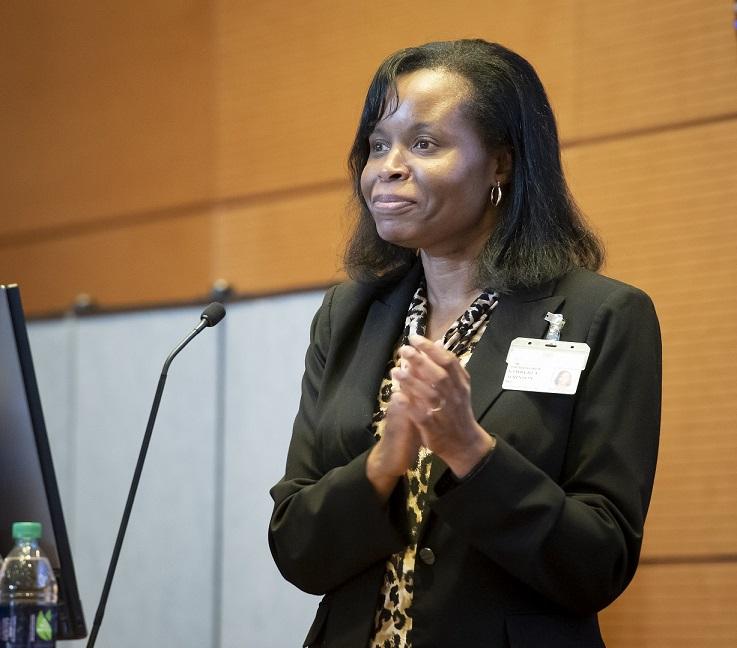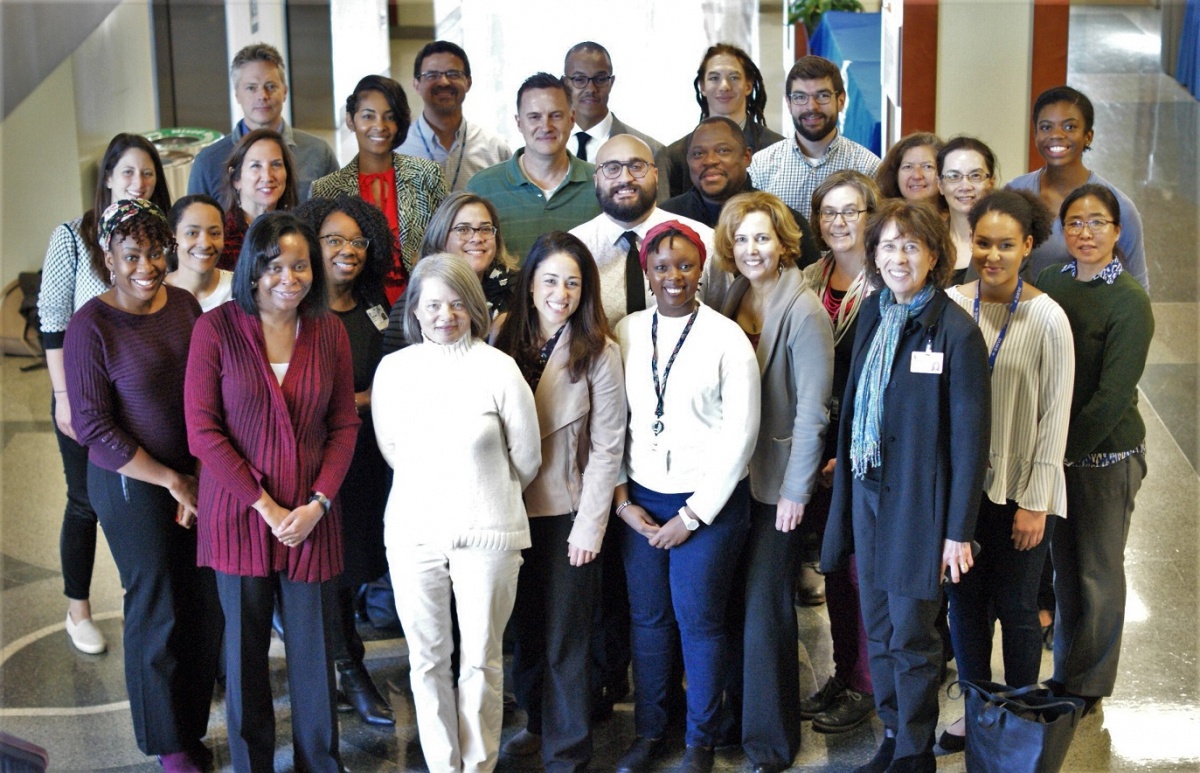
By Liz Switzer
One of Dr. Kimberly Johnson’s earliest memories of arriving at Duke for her residency in 1997 is the long hallways lined with portraits of white men. Johnson, professor of medicine (Geriatrics) and director of the Duke Center for Research to Advance Health Equity, also called the REACH Equity Center, has since earned her own place in the hallowed halls of Duke—and beyond.
Since completing her Duke fellowship in 2002, Johnson has worked to close the gap of racial disparities in the quality of end-of-life care for older African Americans, becoming nationally known for her research on the topic. As PI of the REACH Equity Center, she focuses on the quality of clinician-patient communication to reduce racial and ethnic disparities on a broad scale, working with large multidisciplinary teams from across the Duke campus to conduct and support research that addresses the issue.
“Her work gives me hope that we can finally make substantive progress in closing the shameful health disparities that continue to plague U.S. healthcare,” says Cathleen Sellner Colon-Emeric, MD, chief, Division of Geriatrics.
“In Duke Health, we are extremely fortunate to be able to benefit from Kimberly’s exceptional leadership and deep commitment as we advance health equity,” says A. Eugene Washington, MD, chancellor for health affairs at Duke University and president and CEO of Duke University Health System. “She is a dedicated clinician and outstanding researcher who contributes significantly to eliminating racial disparities in health care locally and beyond. And she is an excellent role model for our entire community.”
Johnson is “a trailblazing champion for health equity” in the words of L. Ebony Boulware, MD, MPH, chief, Division of General Internal Medicine and director, Clinical and Translational Science Institute (CTSI). “As the Director of REACH Equity, she has ushered in a sea-change at Duke and across the nation, leading and promoting rigorous scientific studies to understand why health inequity occurs––especially in health care settings––and how to address it,” says Boulware. “She has also trained an entirely new generation of researchers in this area as well, paving the way for many more studies to address this problem now and in the future. She is an incredible leader and a wonderful role model, and we are so fortunate to have her at Duke!”
Creating Communities of Equity
Johnson also devotes a great deal of her time to mentorship, creating a community of scholars to work on racial disparities in health care well into the future. Among her many accolades, in 2021 she received the first annual Neil L. Spector Art of Medicine Award, which recognizes exemplary mentorship practices in clinical and translational research, and the School of Medicine’s Career Mentoring Award in Clinical and Population Health Science. In 2020, Johnson received the American Academy of Hospice and Palliative Medicine Richard Payne Outstanding Achievement in Diversity, Equity, Inclusion Award.
 Based on her own experiences growing up in the segregated South, the diversity of perspectives has always loomed large in Johnson’s life. From her childhood in Mound Bayou, Miss.—a town founded by former slaves—to her undergraduate days at the historically black Dillard University in New Orleans and earning a medical degree from Johns Hopkins University in 1997, Johnson says she has always been, and still is, keenly aware of her identity as a Black woman.
Based on her own experiences growing up in the segregated South, the diversity of perspectives has always loomed large in Johnson’s life. From her childhood in Mound Bayou, Miss.—a town founded by former slaves—to her undergraduate days at the historically black Dillard University in New Orleans and earning a medical degree from Johns Hopkins University in 1997, Johnson says she has always been, and still is, keenly aware of her identity as a Black woman.
“I don't have an identity as a woman,” Johnson says, “my identity is very much as a Black woman. I don't think that people see me as a woman, without first seeing me as Black. That’s true for most any space where I find myself. Certainly, issues around being a woman and medicine are really important, but they are magnified in many ways when you're a Black woman. The numbers of women in leadership roles have increased, but the number of Black women still remains small in these spaces. This is why it is important to have more female physicians and leaders, and more Black female physicians and leaders.”
According to the Association of American Medical Colleges in 2018 for all practicing physicians an estimated 2.6 percent are Black females.
In Mound Bayou in the late 1980s, Johnson’s early roles models were Black male doctors at local community health center. That’s where she began forming her own opinions about access to care for members of her community, which led her into issues around racism and social justice and later medicine.
Social Justice for All
Using a wide range of methodologies, Johnson has led large national studies of hospice providers and multi-site studies of academic and community-based organizations to improve the quality of palliative care for older, seriously ill African Americans, engaging a broad group of stakeholders that includes clinicians, patients, caregivers, health system leaders, public health officials, clergy, and community leaders.
In her work, Johnson has found lower rates of hospice enrollment among African Americans. She has identified multi-domain and multi-level factors associated with racial disparities in the quality of palliative care for African Americans, exploring such topics racial variation in knowledge, beliefs and attitudes toward hospice, and geographic variation and organizational factors associated with racial disparities in hospice use. Findings of her work suggested that potential reasons for lower use of hospice among African Americans were less knowledge about hospice, lack of information about hospice until hospitalization prior to death leading to late referral, and greater preference for life-prolonging therapies among African Americans even in the face of poor prognosis. This body of work increased knowledge of investigators, clinicians, and professional organizations about racial disparities in hospice use and potential causes. Other work has identified the importance of social supports nationally for hospice patients and the need, frequency and content of cultural competence training programs for hospice staff, among other best practices.
Her research into clinical encounters suggests that providers and health systems are important contributors to health disparities while most studies of interventions to reduce disparities have focused on changing patient behavior and knowledge, leaving substantial gaps in the evidence base of effective interventions to reduce disparities in healthcare delivery.
REACH Equity Center
The REACH Equity Center was established in 2017 with a Centers of Excellence grant from the National Institute on Minority Health and Health Disparities (NIMHD). While most studies of interventions to reduce disparities have focused on changing patient behavior and knowledge, REACH Equity is attempting to address substantial gaps in the evidence base of effective provider and health system level interventions to reduce disparities in healthcare delivery by focusing on the clinical encounter. The Center’s investigators lead three large research projects of provider level interventions—implicit bias education, communication coaching, and needs-based applications.
Under Johnson’s guidance, the Center has provided grants to over 50 investigators across the Duke continuum of learners, from undergraduates to senior investigators with many projects being funded in part with support from the chancellor’s office and the School of Medicine Dean’s Office.
"Dr. Johnson’s passionate commitment to improving minority health has been a key driver of important work to reduce health disparities and promote equitable health outcomes,” said Mary E. Klotman, MD, Dean, Duke University School of Medicine. “Under her leadership, Duke’s REACH Equity Center has created a collaborative environment among a team of very talented investigators– all working to develop and test interventions that will have a significant impact in our local community and far beyond.”
Johnson’s leadership of the REACH Equity has been “masterful,” says Laura Svetkey, MD, professor of medicine (Nephrology), and associate director of the Center who worked alongside Johnson to secure the NIMHD grant, “a strong guiding hand that makes every member of the team know they are included and valued. Svetkey and Johnson also co-direct Duke’s Clinical and Translational Science Award-sponsored career development award program, KL2.
“In my decades at Duke, I’ve worked with and for many leaders,” Svetkey says. “I put Kimberly at the very top of that list for two main reasons. First, as a scientist, she is meticulous in relying on evidence, developing precise and answerable research questions, using the most rigorous methodology, and grounding her science in ‘the why’. She starts every presentation with a patient story, often one with personal meaning for her, that makes it crystal clear why the work she’s about to describe is important, why we should care about it. And then she explains in precise detail how science can be galvanized to help that patient and others like her, moving swiftly from description to intervention. Second, she is a leader who inspires and energizes, while keeping all the cats well-herded.”
Since the two began working together 2013 on the KL2, Svetkey adds, they’ve met alone, or in groups, at least 100 times each year. “I always, every time, come away from that meeting feeling more excited and optimistic about the work,” she says. “Kimberly has applied this approach to science and leadership to the challenging and critical work of eliminating racial health disparities, to the enormous benefit to Duke and the nation.”
Photos courtesy of Les Todd and Tia Mitchell. The center image is from a REACH Equity team retreat and includes center staff, the center research project teams, center core and sub-core teams, and other investigators who are a part of REACH Equity.